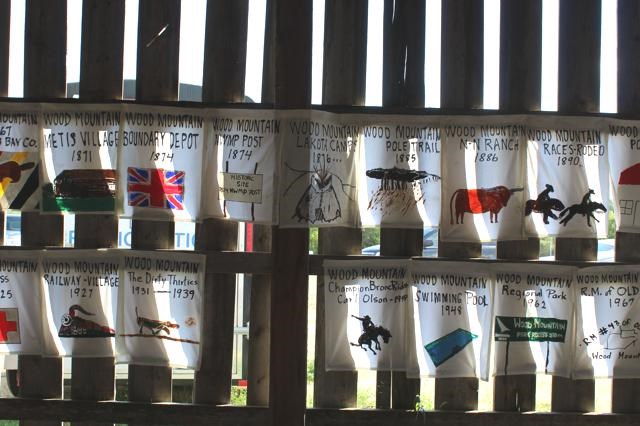Submitted by S.Falconer
The Wood Mountain Rodeo Ranch Museum celebrated Canada 150 and the rich history of the south region at an event called “150 years of Milestones and History in the Wood Mountain Uplands” at the museum on July 2. Jody Hordenchuk was the narrator for the afternoon program. Carl and Camille Anderson provided musical interludes with guitar and violin between many of the segments.
The program began with the acknowledgement of some of the first people in the area including the Atsina, the Anishinabi, the Neohawat Cree, the Nakota, Dakota and Lakota. To honor these nations, Katherine Robichaud, wearing traditional dress, performed the “Jingle Dance”.
Glentworth School Grades 6, 7 and 8 students created banners to depict many of the historical highlights. While the narrative unfolded, the banners were displayed by Jack Hordenchuk and Katherine Robichaud.
As European Nations arrived on the scene, fur trading companies set up a commercial enterprise. In 1867, the Hudson’s Bay Company established a Post at Wood Mountain. Isaac Cowie related that story in the book “The Company of Adventurers”.
The banner was displayed for the Post while Carl and Camille Anderson provided Scottish music. Bill Wilson read a description of an early trading post from “Wood Mountain Uplands”. During that year in 1867, four colonies in Eastern Canada formed a country under British rule to become Canada. The singing of “O Canada” was led by Gina Stewart and Carolyn MacDonald.
Living in the West were many families of First Nations, French and Scottish ancestry. Some of them, including the Metis buffalo hunters, disagreed with the sale of the land. Even before the province of Manitoba was formed, they followed the buffalo west and started new settlements. One of these settlements was located in the Wood Mountain Uplands.
In 1874, the British North American Boundary Commission was organized to survey the 49th parallel. A supply center consisting of a single log cabin was constructed next to the Metis village at Wood Mountain. Soon, the newly-organized North-West Mounted Police were sent to patrol the boundary and to maintain law and order in the West.
Several thousand Lakota moved to Canada after the Battle of the Little Bighorn across the border in the U.S. and they were supervised by the NWMP. The Police Post became a patrol center along the boundary in 1885 when the “Pole Trail”, a telegraph line was constructed to provide communication with Moose Jaw and Regina.



